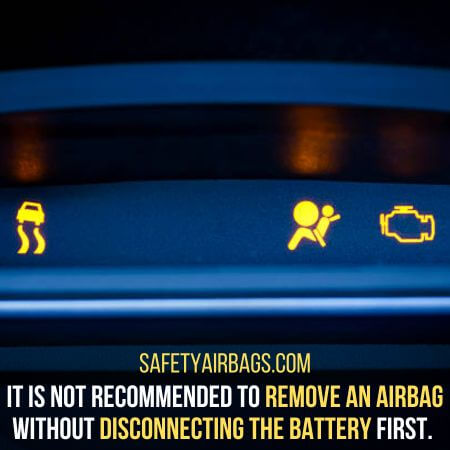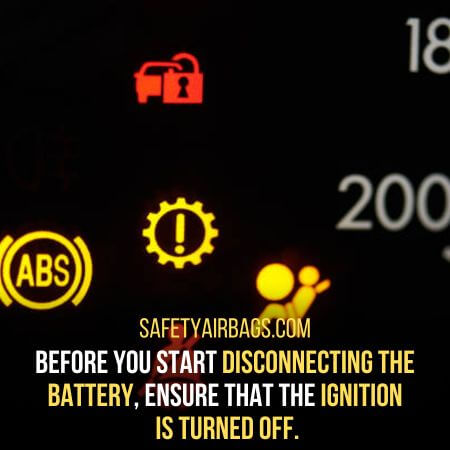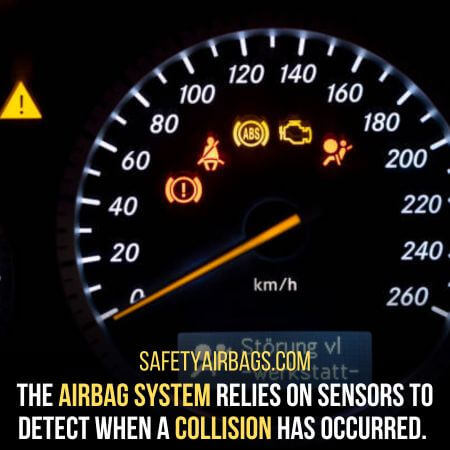Can we remove an airbag without disconnecting its battery? It is not recommended to remove an airbag without disconnecting the battery first.
What Will I learn
- 1 Can We Remove An Airbag Without Disconnecting Its Battery?
- 2 Potential Risks Of Removing An Airbag Without Disconnecting Its Battery
- 3 Safety Procedures For Working With Airbags:
- 4 How To Safely Disconnect The Battery
- 4.1 Step 1: Turn Off The Ignition And All Electrical Devices In The Vehicle:
- 4.2 Step 2: Locate The Battery In The Vehicle:
- 4.3 Step 3: Identify The Negative (-) Terminal:
- 4.4 Step 4: Loosen The Negative Cable.
- 4.5 Step 5: Remove The Negative Cable.
- 4.6 Step 6: Secure The Negative Cable.
- 4.7 Step 7: Identify The Positive (+) Terminal.
- 4.8 Step 8: Loosen The Positive Cable.
- 4.9 Step 9: Remove The Positive Cable.
- 4.10 Step 10: Secure The Positive Cable.
- 4.11 Step 11: Wait Before Reconnecting The Battery.
- 5 How Airbags Work – Understanding Its Mechanism
- 6 Conclusion:
This article will discuss the potential risks of removing an airbag without disconnecting the battery. Also, we will explain the proper safety procedures to follow when working with airbags.
Can We Remove An Airbag Without Disconnecting Its Battery?
The airbag system is designed to be highly sensitive. Therefore, it could deploy unexpectedly if the airbag is removed while the battery is still connected.
Additionally, electrical components near the airbag may be damaged if power is still flowing to the system.
Thus, removing an airbag without disconnecting its battery is extremely dangerous.
Airbag System Is Highly Sensitive:
The airbag system in a vehicle is designed to deploy rapidly in the event of a collision.
It relies on complex sensors, wires, and control modules to function properly. These highly sensitive components can be easily disrupted if not handled properly.
Even a small amount of force or vibration can trigger the airbag system, leading to unexpected deployment.
Potential Risks Of Removing An Airbag Without Disconnecting Its Battery
Now let’s talk about the consequences of doing the dangerous act. First, it’s safe to avoid it at all costs:
1. Electrical Shock:
Electrical shock is one of the biggest risks of removing an airbag without disconnecting the battery.

Airbag systems are designed to generate a lot of energy in a short period, and this energy is stored in the airbag module.
Therefore, if you remove the airbag without disconnecting the battery, you risk electrical shock.
This can be especially dangerous if you’re unfamiliar with your vehicle’s electrical systems.
2. Accidental Deployment:
Another potential risk of removing an airbag without disconnecting the battery is accidental deployment. Even if the car’s ignition is off, the airbag system may still be armed.
It could deploy unexpectedly if you accidentally hit the airbag sensor or any other component of the airbag system while removing it. This could cause injury to you or anyone nearby.
3. Damage To The Airbag System:
Removing an airbag without disconnecting the battery can also damage the airbag system.
The airbag module contains several sensitive components, including capacitors, wiring, and sensors.
If you accidentally damage any of these components while removing the airbag, it could cause the airbag system to malfunction.
This could result in the airbag failing to deploy in the event of an accident or deploying unexpectedly.
4. Difficulty Reassembling The Airbag System:
Removing an airbag without disconnecting the battery can also make it more difficult to reassemble the airbag system.
Airbag systems are designed to be very precise. Even small variations in component placement or wiring can cause the system to malfunction.
In addition, if you’re unfamiliar with your vehicle’s airbag system, you may have difficulty putting it back together properly.
This could result in the airbag failing to deploy in the event of an accident or deploying unexpectedly.
5. Invalidating The Warranty:
Removing an airbag without disconnecting the battery could also invalidate the warranty on your vehicle.
Most car manufacturers require that airbag systems be serviced only by authorized technicians. They may require the battery to be disconnected before any work on the airbag system.
Therefore, attempting to remove the airbag yourself without disconnecting the battery could violate your vehicle’s warranty terms.
6. Legal Consequences:
Finally, there may be legal consequences to removing an airbag without disconnecting the battery.
Airbag systems are a critical safety component in your vehicle. Tampering with them could result in legal consequences if someone is injured in an accident due to the airbag malfunctioning.
In addition, some states have laws that make removing or disabling airbags illegal.
Safety Procedures For Working With Airbags:
Airbags are an important safety feature in modern vehicles. They protect the occupants in a collision, reducing the risk of serious injury or death.
However, working with airbags can be dangerous. It is important to follow proper safety procedures to prevent accidents. Here are some safety procedures to follow:
1. Read The Owner’s Manual:
The owner’s manual contains information about the location of airbags in the vehicle and the proper safety procedures for working with them.
Reading and understanding this information is important before working on the airbags.
2. Wear Proper Safety Gear:
Always wear safety glasses and gloves when working with airbags to protect your eyes and hands from injury.

The procedure is a dangerous one, thus, safety gears are important for any individual.
3. Avoid Static Electricity:
Airbags are sensitive to static electricity, so it is important to avoid generating static electricity when working with them.
This can be done by wearing cotton clothing and avoiding synthetic materials.
4. Disconnect The Battery:
Before working on any part of the airbag system, it is important to disconnect the battery to prevent accidental deployment.
Disconnecting the battery is a simple but important procedure that should be followed carefully to ensure safety.
How To Safely Disconnect The Battery
Whether performing maintenance on your vehicle or working on any electrical system, it is crucial to know how to disconnect the battery properly.
Here are all the steps to follow when disconnecting the battery.
Step 1: Turn Off The Ignition And All Electrical Devices In The Vehicle:
Before you start disconnecting the battery, ensure that the ignition is turned off and that all electrical devices in the vehicle are also turned off.

This will prevent accidental sparks or electrical charges while working on the battery.
Step 2: Locate The Battery In The Vehicle:
The battery in your vehicle is usually located under the hood. However, some cars have batteries in the trunk or under the back seat.
Check your owner’s manual to locate the battery in your specific vehicle.
Step 3: Identify The Negative (-) Terminal:
Once you have located the battery, you must identify the negative (-) terminal.
The negative terminal is usually marked with a minus (-) sign or the letters “NEG” or “–”. This terminal is usually black.
Step 4: Loosen The Negative Cable.
Using a wrench or pliers, loosen the nut securing the negative cable to the battery’s negative terminal.
Turn the wrench or pliers counterclockwise to loosen the nut. It is important to loosen the negative cable first.
It can prevent any electrical charge from the battery while working on the positive cable.
Step 5: Remove The Negative Cable.
Once the nut is loosened, carefully remove the negative cable from the battery’s negative terminal.
Be careful not to touch any other metal parts with the negative cable.
Step 6: Secure The Negative Cable.
After you have removed the negative cable, make sure to secure it away from the battery terminal.
This will prevent it from accidentally contacting the terminal while you are working.
Step 7: Identify The Positive (+) Terminal.
Now that you have disconnected the negative cable, you can move on to the positive cable.
The positive terminal is usually marked with a plus (+) sign or the letters “POS” or “+”. This terminal is usually red.
Step 8: Loosen The Positive Cable.
Using a wrench or pliers, loosen the nut securing the positive cable to the battery’s positive terminal.
Turn the wrench or pliers counterclockwise to loosen the nut.
Step 9: Remove The Positive Cable.
Once the nut is loosened, carefully remove the positive cable from the battery’s positive terminal.
Be careful not to touch any other metal parts with the positive cable.
Step 10: Secure The Positive Cable.
After you have removed the positive cable, make sure to secure it away from the battery terminal.
This will prevent it from accidentally contacting the terminal while you are working.
Step 11: Wait Before Reconnecting The Battery.
After disconnecting the battery, it is important to wait at least 15 minutes before reconnecting it.
This will allow any residual charge in the electrical system to dissipate, ensuring it is safe to work on the electrical system.
How Airbags Work – Understanding Its Mechanism
Airbags are designed to protect occupants in the event of a collision. When a collision occurs, the airbag system is activated.
The airbags deploy rapidly to provide a cushion between the occupant and the vehicle’s interior. This helps to reduce the risk of serious injuries, particularly head and chest injuries.
The airbag system in a vehicle consists of several components, including:
1. Sensors:
The airbag system relies on sensors to detect when a collision has occurred. These sensors are typically located in the front of the vehicle.

They are designed to detect changes in momentum and deceleration.
2. Control Module:
The control module is the brain of the airbag system. It receives signals from the sensors and decides whether to deploy the airbags.
The control module also controls the timing of the airbag deployment.
3. Airbag Module:
The airbag module consists of the airbag itself, the inflator, and the housing.
When the airbag is deployed, the inflator releases a gas burst that fills it and causes it to inflate rapidly.
4. Seat Belts:
Seat belts are an essential component of the airbag system, as they help to keep the occupant in the correct position during a collision.
The seat belt also helps distribute the collision’s force across the body, reducing the risk of injury.
Conclusion:
In conclusion, removing an airbag without disconnecting the battery can pose serious risks.
The driver’s and passengers’ safety should always be the top priority when working on a vehicle.
Airbags are an essential safety feature that can save lives in the event of a collision, but they must be handled with care.
By following proper safety procedures, you can help ensure your safety and the safety of others while working on your vehicle.
Always consult a professional mechanic if you are unsure about any aspect of working on your vehicle’s airbag system.
